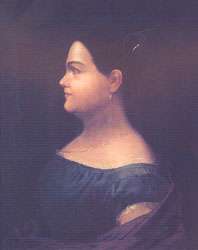Leona Vicario

'María de la Soledad Leona Camila Vicario Fernández de San Salvador', best known as 'Leona Vicario' (April 10, 1789 – August 24, 1842), was one of the most prominent figures of the Mexican War of Independence. She was dedicated to informing insurgents of movements in her home Mexico City, the capital of the viceroyalty. She was a member of Los Guadalupes, one of the earliest independence movements in New Spain. She financed the rebellion with her large fortune. She was one of the first female journalists in Mexico. Driven by strong feminist beliefs, she took many risks and sacrificed much wealth in the name of liberation.
Vicario has been given the title "Distinguished and Beloved Mother of the Homeland" by the Congress of the Union. Her name is inscribed in gold in the Mural of Honor in the lower house of the Mexican Congress.
Biography
Leona Vicario was an only child, the daughter of a wealthy businessman from Castilla la Vieja, Spain. Her mother was Camila Fernandez de San Salvador, from Toluca. Leona acquired an extensive education in the sciences, fine arts, painting, singing, and literature.
Upon the death of her parents in 1807, she remained in the custody of her uncle and legal guardian Agustín Pomposo Fernández de San Salvador, a lawyer. Her uncle allowed her to live alone but bought a property adjacent to hers, something scandalous in the custom of the time. Her uncle arranged an engagement to Octaviano Obregon, a lawyer and colonel, but he was sent to Spain as a deputy to the Courts of Cadiz. She fell in love with Andrès Quintana Roo.
She worked with a secret society called Los Guadalupes to received and distribute insurgent correspondence for the independence movement. She served as a messenger, helped fugitives, sent money and medicine, and helped in all she could. She fled her home in 1813, because her insurgent activities were discovered. Fernández de San Salvador convinced her to return, and she was detained and questioned in the College of Belén, but refused to inform on the conspirators. The insurgents rescued her, but the authorities confiscated her property. She was, however, granted a pension by the insurgent Congress. She married Quintana Roo and they fled from the authorities together. They were discovered in 1817; both accepted amnesty from the royalists.[1]
Leona Vicario and her husband are buried together at Independence Column in Mexico City. She was named the "Sweet Mother of the Fatherland" (Benemerita y Dulcisima Madre de la Patria) by a special commission ordered by then President Antonio López de Santa Anna in August 1842, only days after her death. She was buried in Mexico City and is the only civilian woman to have received a State Funeral.
In 1910, Leona Vicario and Josefa Ortiz de Domínguez were the first women to be depicted on Mexican stamps and the second women to be depicted on stamps in Latin America.[2]
In February 2010, seven months before Mexico celebrated its 200 years of independence, Mexican writer Carlos Pascual published the novel "La Insurgenta." In this novel, in which he uses historical facts and fictional events, Pascual tells the story of Leona Vicario as well as the story of many others who participated in the war for and against Mexican independence from the Spanish Empire.
Her profile also appears on a version of the $5 Mexican coin, surrounded by the words "BICENTARIO DE LA INDEPENDENCIA," meaning "Bicentennial Anniversary of Independence."
See also
References
- ↑ Guedea, Virginia. "Vicario Fernández, [María] Leona (1789–1842)." Encyclopedia of Latin American History and Culture. Ed. Jay Kinsbruner and Erick D. Langer. 2nd ed. Vol. 6. Detroit: Charles Scribner's Sons, 2008. 360. Gale Virtual Reference Library. Web. 11 July 2016.
- ↑ Tipton, James. "The Mexican Postal Service celebrates 100 years of the Mexican Revolution and the Bicentennial of Mexico's Independence". MexConnect. MexConnect.